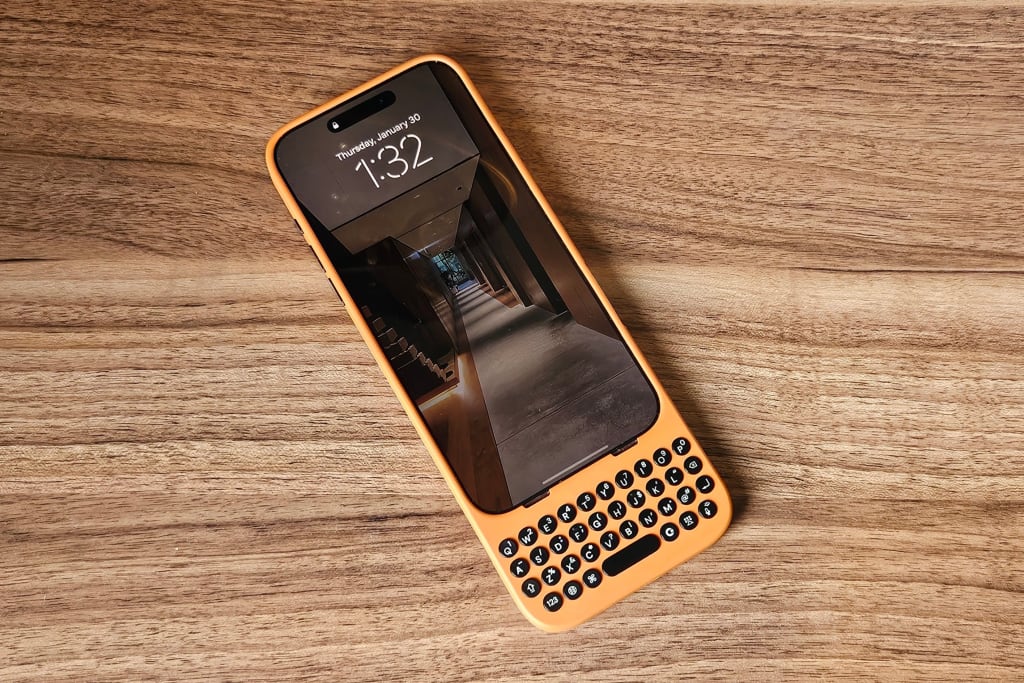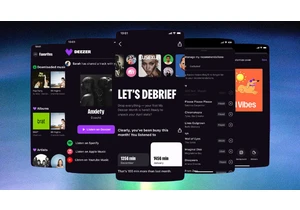A funny thing happened after I stopped using Clicks, the keyboard case that effectively turns an iPhone into an oversized Blackberry: The phone by itself suddenly seemed punier.
I mean that in terms of both size and mightiness. Because while Clicks’ four rows of physical keys stretch an iPhone to comical length, they also add a bunch of powerful shortcuts for getting things done. My typing hasn’t gotten any faster with Clicks, but things like copying, pasting, and switching between apps has become more efficient.
The first Clicks keyboard cases launched a year ago, with tech YouTuber Michael Fisher and Crackberry blog founder Kevin Michaluk co-founding the company to scratch a highly specific itch. The iPhone 16 versions, which just launched in January, have a more sculpted key design that’s easier to type on, while also adding MagSafe accessory support and USB-C data transfer.
They are no less niche, though. As before, the price is $139 for regular-sized iPhones and $159 for the Pro Max and Plus models—not the kind of purchase one makes without being super committed to the concept. But the most I used Clicks, the more I wished for a version that included everything but the keyboard.

Not faster, but more satisfying
I’ve been using Clicks on an iPhone 16 Pro Max for the past few weeks now. While there’s a learning curve—especially with using modifier keys for punctuation—I’ve become pretty adept at thumb typing on Clicks’ physical keys. Still, every time I perform a typing test, the results are about the same with or without Clicks.
The reality is that on-screen keyboards have become pretty efficient on their own. Between gesture typing and auto-correct, a practiced touchscreen typist can rattle off emails or text messages without having to scrutinize each letter, so there’s little time gained from having physical keys beneath the thumbs.
And while Clicks does free up screen space that an on-screen keyboard would normally occupy, the evolution of smartphone design plays against Clicks here as well: Our phones have gotten taller in large part to accommodate the on-screen keyboard, with apps becoming increasingly adept at keeping important details within view. Rarely did I feel like Clicks was freeing up essential space.
At best, the typing upside with Clicks is vibes-based. While I never owned a BlackBerry and don’t feel the nostalgia of using a modern-day homage, the tactile keys still feel substantial in a ways that software keys don’t. On some level, writing with Clicks feels a little more like an accomplishment, even if it’s not any faster.

Keyboard command center
The Clicks keyboard is about more than just typing, though. The real utility is in its ability to execute commands.
On the most basic level, Clicks supports the same keyboard shortcuts you’d get by connecting your iPhone or iPad to a Bluetooth keyboard. Instead of shaking your phone or using the unreliable three-finger swipe gesture to undo, you can just click Cmd+Z. Instead of tapping the exact point of text insertion and waiting for the tiny “paste” button to pop up, you can just click Cmd+V. You can even use app-specific shortcuts, such as Cmd+T and Cmd+W to open and close new browser tabs in Safari.
Navigational shortcuts are even better. Hitting Cmd+Space brings up Spotlight, where you can access apps, contacts, and Shortcuts just by typing a letter two and hitting Enter. Unlike the touchscreen version, which requires a return to the home screen, the keyboard shortcut works from anywhere, even inside other apps. Combined with some other navigational shortcuts—Cmd+H for Home, Globe+N for notifications, Globe+C for Command Center—Clicks lets you quickly get around iOS without taking fingers off the keyboard.
There’s also a hidden feature that goes a step further, letting you set up custom keyboard commands to run automations from the iOS Shortcuts app. It requires some rooting around in Accessibility settings, but in the end you can have keyboard shortcuts for things like launching a favorite app, taking a quick note, or opening your preferred AI assistant. It’s kind of like having a bunch of iPhone 16 Action Buttons lined up on the bottom of your phone.\

Unforeseen consequences
Too bad these extra capabilities come with some significant trade-offs.
Obviously, there’s the size of the thing. The iPhone 16 Pro Max with Clicks just barely fits in my pants pockets and isn’t comfortable to sit with, so I’ve been more prone to just plopping it onto the nearest table.
Other annoyances are just inherent to using a physical keyboard instead of the on-screen one:
- If you use a third-party password manager like Bitwarden, there’s no persistent bar above the keyboard for accessing passwords or two-factor authentication codes. You can auto-fill logins through an on-screen pop-up, but this doesn’t let you select alternative logins and sometimes failed to work properly.
- One-handed typing takes more effort, especially with the phone being more top-heavy. While Clicks has a button to bring up the on-screen keyboard, it’s still more cumbersome to type on with a full row of physical keys under your palm.
- Clicks’ backlit keys don’t light up until you press them, so a lot of times I had to guess at the first keystroke while trying to type in the dark. (I wish the keys lit up whenever you tapped on a text entry field, but I’m not sure if iOS allows for that.)
Clicks’ unusual shape can lead to some awkward charging and docking scenarios as well. Clicks doesn’t fit at all in my car’s wireless charging tray, and I have to flip the phone upside down to use the upright wireless charger on my nightstand. And while Clicks for iPhone 16 has MagSafe support, it’s too tall and heavy to fit on the MagSafe vent mount in my wife’s car.

The case for a keyboard-less Clicks
In the end, Clicks’ slightly more satisfying typing experience doesn’t seem worth all those trade-offs to me. But when I went back to using my iPhone by itself, I missed having all of Clicks’ extra shortcuts under my thumbs.
What I really want from Clicks, then, is everything but the thing for which it’s best-known. Instead of a full keyboard, give me a version with just a single row of shortcut keys, allowing me to efficiently manipulate text, navigate iOS and trigger my most-used Shortcuts. Take the iPhone’s Action Button, in other words, and multiply it by eight or 10 at the very bottom of the phone.
Dispensing with physical keys for typing wouldn’t slow me down at all, but it would sidestep Clicks’ biggest compromises while preserving its greatest strengths. Would a company founded by former Blackberry addicts countenance such a thing? I don’t know, but I’d probably buy one.
Login to add comment
Other posts in this group

If real Easter eggs aren’t your thing this weekend, you may find hunting for digital ones more enjoyable. And there are some cool ones to find at your fingertips, provided you have an iPhone or Ma

With music streaming, users have gotten used to being at the mercy of algorithms. But French music streamer Deezer is making it easier for its subscribers to make the algorithm work for them.

Trying to get from point A to point B? If only it were that simple! With any manner of travel these days, you’ve got options: planes, trains, buses, ferries, and beyond. And finding the best

When Twitter cofounder and Medium founder Evan “Ev” Williams was planning his 50th birthday party, he didn’t know who to invite. Having spent more of his life building and scaling tech

If you thought you’d heard the last of the viral “Apple” dance, think again. The TikToker behind it is now suing Roblox over its unauthorized use.
Last year, during the height of Brat su

A Wall Street Journal report this week gave an extensive look into how Elon Musk, the

Netflix fared better than analysts anticipated during the first thr
